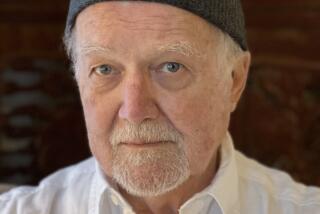‘The Hospital for Bad Poets: Stories’ by J.C. Hallman
The Hospital
for Bad Poets
Stories
J.C. Hallman
Milkweed Editions: 256 pp.,
$16 paper
Fans of J.C. Hallman’s bracing nonfiction know him as a writer drawn to the lyric and bizarre. His two previous books, “The Chess Artist” and “The Devil Is a Gentleman,” were loose travelogues that sent him happily zinging to the distant frontiers of human belief.
In his new collection of stories, “The Hospital for Bad Poets,” Hallman cuts loose from the tether of the known world altogether in favor of a brainy surrealism. Like Kafka before him, he’s on the make for the sturdy truths in an era of spiritual dislocation.
One of which is most assuredly: Beware those who come home for the holidays. The unhappy narrator of “Ethan: A Love Story” does this, attempting to reconnect with a family that regards him with contempt. Our hero takes refuge in the basement, where he plays the video game Halo with his neglected young nephew, Ethan.
Like a number of Hallman’s tales, this one is set in the false utopia of a suburban subdivision, and he gets the details of the place just right: the sterile replication of design elements, the elaborate security systems, the golf course abandoned for winter. “The fairways themselves had frozen over. The expensive grass crunched loudly underfoot, and I left trails like the footprints of a ghost.”
That Hallman renders the narrator’s kin as sadists who blithely cheer America’s imperialism can be fairly regarded as dirty pool. Then again, the story is set at the height of the Bush era. And it’s hard not to find the denouement satisfying, as Ethan and his bleeding-heart uncle use their video game controllers to eviscerate assorted relatives.
One of the joys of reading Hallman is the way in which he takes familiar plotlines and works them into more abstract meditations. “Autopoiesis for the Common Man” opens with the declaration, “I was dating two nurses at once,” but rejects the standard saga of betrayal implied by the love triangle. Instead, his paramours reduce his romantic yearnings to microbiological jargon, leaving him dizzied. He winds up wooing a nursing student drunk enough to accept a ride home. “She looked out my windshield, splattered with dirt and mud and bugjuice, an ugly mural that was a record of my night, my trips here and there, all the hope and bad news.”
I should be honest in admitting that, for me, the central pleasure in reading Hallman resides not in his plots, which tend to meander, but in the sly asides he dispenses along the way. “Marci I met at a bookstore poetry reading,” he notes, in the same story. “I went to poetry readings, I admit, to make sure the poets weren’t up to anything interesting.”
“Manikin” offers another fractured family, in which dad has just flown the coop, leaving behind a wife and two teenage children. The story ponders the futility of blood relations, but what stayed with me was the moment in which 15-year-old Van watches his sister react to the news. “Kara, seventeen, tossed her hair as she read the note. The glowing strands dripped away from her fingers as she comprehended it, and Van couldn’t help noticing it was sexy, that motion, and that it was designed that way. His sister was a sexy girl, but it wouldn’t last her long or get her far.” Ouch.
“The Year of the Diva,” likewise, doesn’t amount to much more than a riff on pop music. But the opening lines crackle with so much unexpected music that the story feels momentous: “It was the year of the diva. The song, the Irish lilt, wormed into every knothole. Boomed from lowriders, from radio stations at gyro stands, from the rubber-band clarinet of a street musician who had fingered the melody note by note, from the fat throat of a businessman pissing bourbon and salt onto a paper plate in an alley, embarrassed when I heard him tootling on.”
The most satisfying story is “Double Entendre,” in which a pair of ardent sexual adventurers must contend with the interventions of a narrator bent on explaining the significance of erotica. “We humans tend to prefer our sex a tad scary,” he lectures. “Shrewd writers capitalize on this. Hot fiction is real people reacting to a situation that frightens them, pushes their boundaries.”
Fair enough. But the finest passages here give free rein to Hallman’s descriptive powers, which call to mind James Salter’s. The story’s leading man “opens his eyes and scans across the broad expanse of the rest of her, and she is tilted back, propped on her shoulders, and her fingers scrape over his forearms, and her belly stutters her pleasure, and she is lovely in the yellow light.”
The closer Hallman cleaves to the emotional lives of his characters, the better his prose becomes. Which is a polite way of saying that some of the pieces feel more like intellectual excursions than stories. They’re chock-full of interesting sentences and ideas but feel insulated from the emotional dangers that mark his best work. I found myself wishing, more than once, that Hallman would drop the clever conceits and train his keen eye on the veiled forms of suffering that lie at the heart of all anomie.
Almond is the author of the essay collection “(Not That You Asked).”
More to Read
The biggest entertainment stories
Get our big stories about Hollywood, film, television, music, arts, culture and more right in your inbox as soon as they publish.
You may occasionally receive promotional content from the Los Angeles Times.






